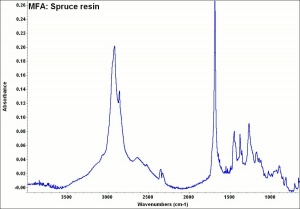Difference between revisions of "Spruce"
JMcGlinchey (talk | contribs) |
JMcGlinchey (talk | contribs) |
||
| Line 16: | Line 16: | ||
==Other Properties== | ==Other Properties== | ||
| − | Paper fiber type: Softwood. Using transmitted light microscopy, fibers are identified by the presence of very small, oval, piceoid ray parenchyma pits, 2-4 across. May show cupressiod or taxodiod features. Ray tracheids are non-dentate. Appearance with [[Graff "C" stain]]: varies with pulping method . Average dimensions of fibers: length, 3.4mm width 3.1 μm. Common pulping method: kraft and sulfite. | + | Paper fiber type: Softwood. Using transmitted light microscopy, fibers are identified by the presence of very small, oval, piceoid ray parenchyma pits, 2-4 across. May show cupressiod or taxodiod features. Ray tracheids are non-dentate. Appearance with [[Graff "C" stain]]: varies with pulping method . Average dimensions of fibers: length, 3.4mm width 3.1 μm. Common pulping method: [[kraft process|kraft]] and [[sulfite process|sulfite]]. |
[[[SliderGallery rightalign|MFA- Spruce resin.jpg~FTIR]]] | [[[SliderGallery rightalign|MFA- Spruce resin.jpg~FTIR]]] | ||
Revision as of 16:03, 25 August 2014
Description
Any of several trees from the Picea family native to North America. Spruce trees, in general, have light weight, soft wood with a straight, even grain. The strong wood is easily worked. It is used for musical instrument sounding boards, ladders, cabinets, boxes, paper pulp, and rayon. Examples include: black spruce (P. mariana), blue spruce (P. pungens), Engelmann spruce (P. engelmannii), red spruce (P. rubens), Sitka spruce (P. sitchensis), and white spruce (P. glauca).
Synonyms and Related Terms
Eastern spruce; épicea (Fr.); Schwartztanne (Deut.); picea (Esp.); espruce (Port.); black spruce (Picea mariana); blue spruce (Picea pungens); Engelmann spruce (Picea engelmannii); red spruce (Picea rubens); Sitka spruce (Picea sitchensi); white spruce (Picea glauca)
| Density | 23-44 ppcf |
|---|
Other Properties
Paper fiber type: Softwood. Using transmitted light microscopy, fibers are identified by the presence of very small, oval, piceoid ray parenchyma pits, 2-4 across. May show cupressiod or taxodiod features. Ray tracheids are non-dentate. Appearance with Graff "C" stain: varies with pulping method . Average dimensions of fibers: length, 3.4mm width 3.1 μm. Common pulping method: kraft and sulfite.
Additional Information
Schoch, W., Heller, I., Schweingruber, F.H., Kienast, F., 2004:Wood anatomy of central European Species: Common Spruce,Norway Spruce, Picea abies Karsten
Additional Images
Authority
- G.S.Brady, Materials Handbook, McGraw-Hill Book Co., New York, 1971 Comment: p. 758
- F. H. Titmuss, Commercial Timbers of the World, The Technical Press Ltd., London, 1965 Comment: Picea glauca density = 23-33 ppcf
- Dictionary of Building Preservation, Ward Bucher, ed., John Wiley & Sons, Inc., New York City, 1996
- External source or communication Comment: Northern Pine Manufacturers: air-dry weight = 27pcf
- Marja-Sisko Ilvessalo-Pfäffli. Fiber Atlas: Identification of Papermaking Fibers (Springer Series in Wood Science). Springer, 1995.
- Walter Rantanen. "Fiber ID Course." Integrated Paper Services. June 2013. Lecture.
- Edward Reich, Carlton J. Siegler, Consumer Goods: How to Know and Use Them, American Book Company, New York City, 1937
- CRC Handbook of Chemistry and Physics, Robert Weast (ed.), CRC Press, Boca Raton, Florida, v. 61, 1980 Comment: density=30-44 ppcf (0.48-0.70 g/cm3)




